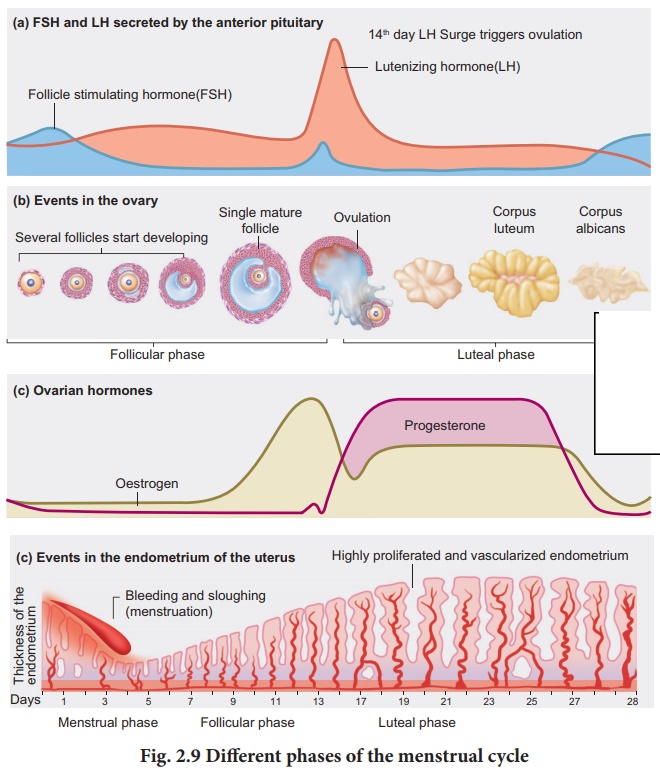Human Reproduction - Menstrual disorders | 12th Zoology : Chapter 2 : Human Reproduction
Chapter: 12th Zoology : Chapter 2 : Human Reproduction
Menstrual disorders
Menstrual
disorders
Absence of menstruation
is called amenorrhoea. If menarche does not appear till the age
of 18, it is called primary amenorrhoea. Absence of menstruation
for over three consecutive months is secondary amenorrhoea.
Polymenorrhoea is a term used to describe
a menstrual cycle that is shorter than 21 days. It may be due to hyperactivity
of the anterior pituitary gland causing frequent ovulation, psychological
disturbances and malnutrition. Chronic pelvic inflammation by certain sexually
transmitted diseases (STD) such as chlamydiasis or gonorrhoea can cause
inflammation in the uterus causing polymenorrhoea.
Pain associated with
menstruation is called dysmenorrhoea. It is the most commonly reported
menstrual disorder. There are two types of dysmenorrhoea viz primary and
secondary dysmenorrhoea. Primary dysmenorrhoea is pain or cramps during
menstrual period and is caused by secretions of prostaglandin in the uterus. Secondary
dysmenorrhoea is caused by a disorder in the reproductive system like
endometriosis or uterine fibroids.
Heavy and prolonged
menstrual period that disrupts a woman’s normal activities is referred to as menorrhagia.
Menorrhagia may be due to hormonal imbalance, ovarian dysfunction, uterine
fibroids and may also be due to cancer of the ovary, uterus or cervix.
Oligomenorrhoea is a condition with infrequent
menstrual periods. It occurs in women of childbearing age. Some variation in
menstruation is normal, but a woman who regularly goes more than 35 days
without menstruating may be diagnosed with oligomenorrhoea.
Menstrual hygiene
Menstrual hygiene is
vital for good health, well-being, dignity, empowerment and productivity of
women. The impact of poor menstrual hygiene on girls is increased stress
levels, fear and embarrassment during menstruation. This can keep girls
inactive during such periods leading to absenteeism from school.![]()
![]() Clean and safe absorbable
clothing materials, sanitary napkins, pads, tampons and menstrual cups have
been identified as materials used to manage menstruation. Changing
sanitary material 4-5 hours as per the requirement, provides comfort, cleanliness
and protection from infections. It also helps in enhancing the quality of life
of women during this period. Used sanitary napkins should be wrapped in paper
and disposed. It should not be thrown in open areas or drain pipe of toilets.
Flushing of sanitary napkins in the drain pipes causes choking of the drainage
line leading to water pollution.
Clean and safe absorbable
clothing materials, sanitary napkins, pads, tampons and menstrual cups have
been identified as materials used to manage menstruation. Changing
sanitary material 4-5 hours as per the requirement, provides comfort, cleanliness
and protection from infections. It also helps in enhancing the quality of life
of women during this period. Used sanitary napkins should be wrapped in paper
and disposed. It should not be thrown in open areas or drain pipe of toilets.
Flushing of sanitary napkins in the drain pipes causes choking of the drainage
line leading to water pollution.
Menopause
Menopause is the phase
in a women’s life when ovulation and menstruation stops. The average age of
menopause is 45-50 years. It indicates the permanent cessation of the primary
functions of the ovaries.
Disposal of Napkins
The ecofriendly way to dispose
menstrual waste scientifically and hygienically is to destroy the sanitary
napkins using incinerators. Measures are being taken to install incinerators
and napkin vending machines in washrooms of schools , colleges and public
facilities.

Related Topics